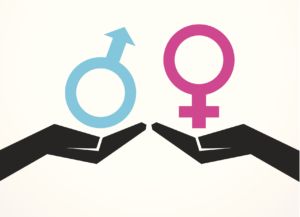For a lot of women out there the week before a period can be, well — trying to say the least. For other women it’s barely a blimp on the menstrual radar.
However, for a small but growing percentage of women symptoms of PMS can go far beyond the stereotypical b*tchy, irritable and hermit-like side effects.
They can be an extreme form of premenstrual syndrome called Premenstrual Dysphoric Disorder (PMDD).
In the beginning, my periods were the “barely a blimp” kind, and PMS symptoms — what PMS symptoms?
My body had never given me reason to train my brain to lookout for certain changes and fluctuations during the week before my period. Even symptoms during my period were incredibly light, just a couple hours of uncomfortable bloating, and three days later it was all over.
I had the kind of premenstrual cycle girls dreamed of!
That is, until my senior year of college.
There’s nothing like being stuck in a room, staring at a computer for days at a time, your eyes darting between Milton chapters and articles on the ICC, for you to start paying attention to the slight changes in your mood.
It was during the finals week of winter, my least favorite quarter, that something shifted and my PMS symptoms noticeably went from being non-existent to making their presence known.
Too known.
At first I didn’t understand it at all, I’d been through many finals weeks and nothing memorable, beyond forgetting a blue book for an exam, had ever occurred.
So when I started having strange feelings of being down, more down that any “off day,” to the point of feeling useless, hopeless, and worthless.
This time, uncontrollable bouts of tears that were followed by awkward fits of laughter were common. Getting out of bed was becoming a struggle, so much so that my roommate once commented “I’ve seen you sitting upright for about twenty minutes today! What’s wrong?”
I was convinced that I must be depressed or bipolar but couldn’t understand why. I wasn’t unhappy, in fact, I was generally quite happy, which only made me feel even more crazy. If I was happy, then what could possibly be making me feel like this?
It took a couple more months of unwarranted quiet spells until I finally went to see the doctor to figure out what on earth was wrong with me.
It never occurred to me that it could have anything to do with my period, because I wasn’t the type of girl that would lose control of her emotions because of something so silly as a period.
But, as soon as my doctor suggested I start writing down dates to chronicle the times these symptoms were most prevalent, the thought that my period could be to blame for all these feelings that were so far outside of my general personality, was the relief I had been waiting for.
Three months later I went back to my doctor, dates in hand and having policed my own symptoms, I had no choice but to notice the changes in myself during the premenstrual week.
It was official, like 8-12% of documented women, I was suffering from mild symptoms of Premenstrual Dysphoric Disorder (PMDD).
Unlike other studies, The American Journal of Psychiatry states than anywhere from 2 to 5% of women suffer from the disorder, the disparaging numbers can be attributed to the difficulties in diagnosing PMDD.
What Are The Symptoms Of PMDD?
Most women (like me) may not even be aware that they suffer from the disorder, especially if symptoms are ignored, which is why it’s so important to be aware of PMDD and conditions like it, whether or not we suffer from them on an individual basis.
One of the key methods used to diagnose PMDD is tracking the recurrence in symptoms and their growing side effects. For a more medical approach to symptom analysis, here are the key symptoms of PMDD to look out for.
- Depressed mood or dysphoria (a feeling of low mood, irritability, anxiety and/or despair)
- Anxiety or tension
- Affective lability
- Irritability
- Decreased interest in usual activities
- Concentration difficulties
- Marked lack of energy
- Marked change in appetite, overeating and food cravings
- Hyper-insomnia or insomnia
- Feeling overwhelmed
- Other physical symptoms, ie: breast tenderness and bloating
(**Note: Five symptoms must be present and at least one of them must be 1, 2, 3, or 4. Symptoms must occur during week before menstruation and remit a few days after the onset of menses.)
Why Did I Wait So Long To Go To The Doctor?
Just as in any cycle of events in which fear is involved, I always look back on this time and wonder, what took me so long to get to the bottom of this? Or better yet, what was holding me back from answers that could help me?
It wasn’t until a few months after my doctors appointment that I realized what had been deterring me from going to see my doctor in the first place. In retrospect, it wasn’t the common fear of the doctor’s office or the discomfort of talking about personal issues with a relative stranger that kept me away.
The fear that allowed me to live with PMDD for far longer than need be was the huge stigma associated with women that are effected by their periods or women that have mood swings at all.
If a woman is in a bad mood or gets upset by something that’s said or done, it’s signs of “the period.” It’s one of the ways a woman’s nature is targeted or used rather as a tool for women to be questioned and question themselves and their emotions.
It’s no wonder that I and so many others like me are hesitant to accept the fact that periods and symptoms related to our premenstrual cycle may play a role in our overall health.
What really sobered my thoughts about my struggle to seek help or listen to the little voice inside my head that urged me to just see the doctor(!) was this conclusion.
I had been more affected and fixated on the idea of becoming the stereotypical girl with period issues than I had been invested in my own health.
I was willing to endure bouts of depression just so I wouldn’t be lumped in with one of those silly girly checklists in “women’s” magazines.
I refused to find myself one day relating to the headline, 25 Reasons Why PMDD Hurts Your Sex Life, on the cover of a Cosmopolitan while standing at the checkout.
The truth is the reality that thoughts and images like that could derail me from seeking help for my PMDD was far more scarier than relating to Cosmopolitan magazine.
When you think about it, it’s ridiculous! Of course PMDD would be a huge factor in women’s overall health, it’s a physiological and hormonal change that even super woman would be affected by.
And if men were able to experience it? Well-let’s not even go there.
What You Can Do To Address PMDD
No matter how long it took, hurdle number one, figuring out what was actually wrong with me was finally over.
And it was time to jump hurdle number two—what can I do about it? After muddling over it and living with the symptoms for longer than I should have, my first step was to talk to a medical professional, and yours (or a friend’s) should be too!
After talking with my doctor, I knew that running towards medication such as anti-depressants was not the answer for me. And although in some cases medication is the most effective way to treat symptoms, it’s not always the case and it’s certainly not the only solution to PMDD.
With this in mind, I looked into some alternative methods of therapy to alleviate my symptoms of PMDD. In my research, I came across “Relaxation Therapy” which can reduce blood pressure, heart rate, and helps slow down brain waves to alleviate stress levels.
Relaxation therapy can be practiced in different forms and can be practiced specifically during the premenstrual week or as part of your daily therapy/exercise. Anything from pilates to meditation practices fall under the relaxation therapy bracket. For me, it was returning to Yoga as part of my daily health routine.
Vitamins and minerals such as calcium, iron and magnesium can also assist with PMDD symptoms. In addition to these, simple changes such as decreasing caffeine intake (the biggest toughie for a nocturnal college student) and increasing cardiovascular activity have been known to help minimize PMDD symptoms and raise serotonin levels that drop during the premenstrual cycle.
Adding dark chocolate (at least 80% cocoa, sorry no semi-sweet Godiva ladies!) also helps to increase serotonin levels that can help with symptoms of irritability and low-moods. Depending on the severity and combination of symptoms, there are homeopathic and natural remedies that can help.
This said, choosing medication is in no way a failure of any sort. Women differ in their needs and it’s important for us to recognize that. If you do choose medication to assist with symptoms of PMDD, these alternatives can be wonderful in accordance with your medication.
The point is, there are options out there for us, whether they’re at the doctor’s office or in the nutrition aisle at whole foods.
Ignoring symptoms because of cliché’s and stereotypes associated with PMS doesn’t make the symptoms go away, and they certainly shouldn’t stop us from seeking the help we may need.
Once we know what we’re facing, steps to addressing these issues can be overwhelming, but they can also be empowering, allowing us to reclaim the direction of our health and the way we think about feminine issues.
One thing I can thank PMDD for is teaching me to listen to my body, and forcing me to recognize changes in my health, both physically and mentally. But most importantly, it taught me that just because it’s a cliché to be affected by one’s period, doesn’t mean it doesn’t happen, and it doesn’t mean it’s not serious.
Addressing my issues with PMDD made me healthier and in turn, happier. The bonus? I now have an excuse to eat chocolate, for one week at least.
Search our 3000+ articles!
Read our articles about:
Our online racial justice training
Used by hundreds of universities, non-profits, and businesses.
Click to learn more





















